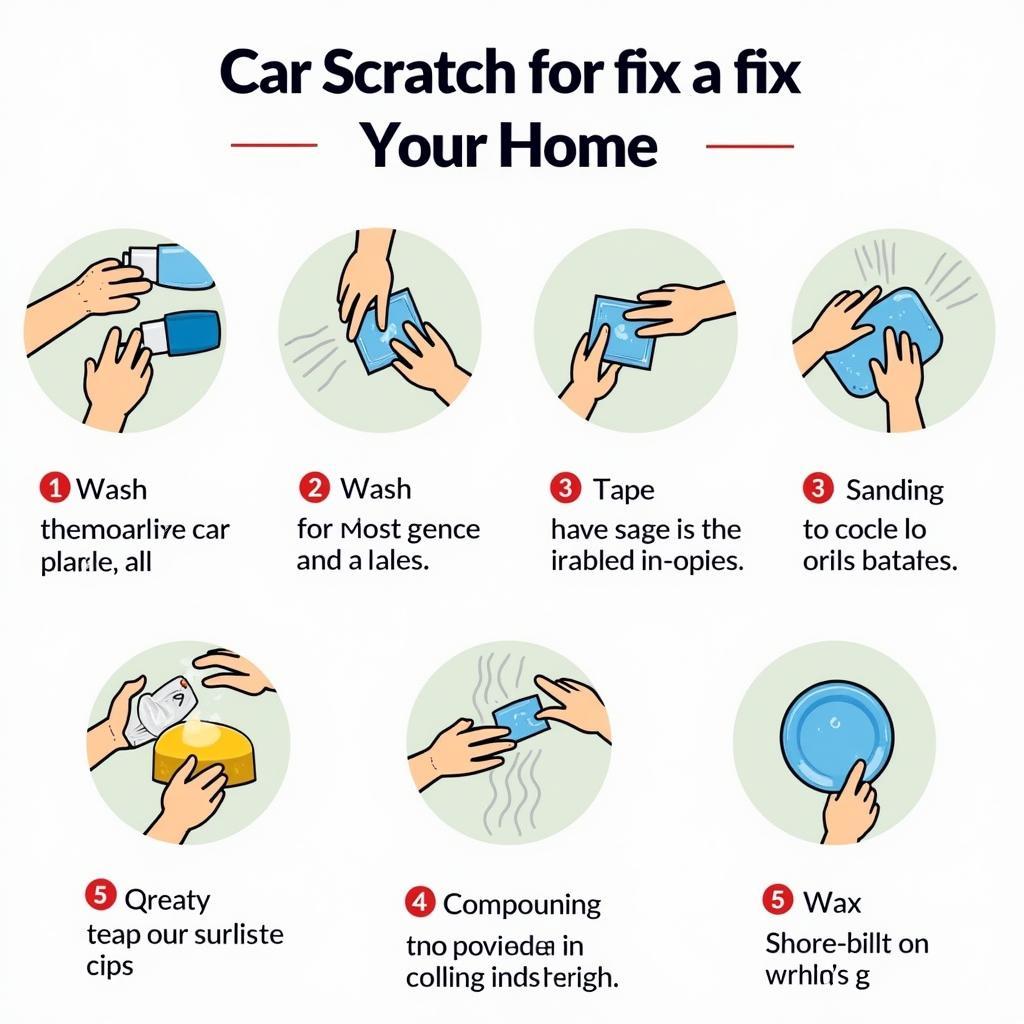Discovering a scratch on your car can be frustrating, but minor scratches can often be addressed at home using simple techniques and readily available materials. This guide provides a step-by-step approach to help you fix a car scratch at home effectively.
Assessing the Scratch: Depth Matters
Before you begin, it’s crucial to determine the severity of the scratch.
- Clear-coat scratches: These are the most superficial type, affecting only the clear coat layer of the paint.
- Paint scratches: These scratches go deeper, penetrating the color layer and exposing the primer underneath.
- Deep scratches: These reach the metal body of the car, often requiring professional attention.
This guide focuses on fixing clear-coat and minor paint scratches at home. For deep scratches, it’s best to consult a professional.
Gather Your Supplies
Having the right tools and materials is essential for a successful scratch repair. Here’s what you’ll need:
- Car wash soap: Use a dedicated car wash soap instead of household detergents, which can strip the car’s wax and cause further damage.
- Microfiber towels: These are soft and lint-free, preventing further scratching during cleaning and polishing.
- Masking tape: This helps protect areas around the scratch during the repair process.
- Sandpaper (2000-grit and 3000-grit): Use these for smoothing out the scratch before polishing.
- Rubbing compound: This abrasive compound helps remove scratches and imperfections from the clear coat.
- Polishing compound: This finer compound restores shine and gloss to the affected area.
- Car wax: Applying wax after the repair protects the finish and enhances the shine.
Fixing a Car Scratch at Home: A Step-by-Step Guide
 Steps to fix a car scratch
Steps to fix a car scratch
Follow these steps to effectively fix minor car scratches:
-
Thoroughly wash and dry your car: This removes dirt and debris that can cause further scratching during the repair process. Ensure the scratched area is completely clean and dry before moving on to the next step.
-
Mask off the area: Using masking tape, create a border around the scratch to protect the surrounding paint during sanding and polishing.
-
Sand the scratch (if necessary): If the scratch is through the clear coat and into the paint, you’ll need to lightly sand the area. Use 2000-grit sandpaper, applying gentle and even pressure in the direction of the scratch. Keep the sandpaper wet and frequently rinse the area to prevent paint damage. Once the scratch is less visible, switch to 3000-grit sandpaper for a finer finish.
-
Apply rubbing compound: Using a clean microfiber cloth, apply a small amount of rubbing compound to the scratched area. Work the compound in circular motions, applying moderate pressure. The compound will gradually remove the scratch and any remaining imperfections. Wipe away any excess with a clean section of the cloth.
-
Polish the area: Once the scratch is no longer visible, apply polishing compound to the area using a fresh microfiber cloth. This step restores the shine and gloss to the paint. Work in circular motions and buff the area until it shines.
-
Apply car wax: As a final step, apply a coat of car wax to the repaired area and its surroundings. This provides an extra layer of protection and enhances the shine.
“Remember, patience is key when fixing car scratches at home,” advises John Miller, an automotive repair specialist at Autotippro. “Take your time with each step, and don’t be afraid to repeat a process if needed.”
Additional Tips for Best Results
- Work in a well-lit area: This helps you clearly see the scratch and ensures even application of the repair products.
- Test the products on an inconspicuous area first: This helps ensure compatibility with your car’s paint and prevents any unexpected reactions.
- Use light pressure: Applying too much pressure can damage the paint. Let the products and sandpaper do the work.
- Be patient: Don’t rush the process. Allow sufficient time for each product to dry and cure before moving on to the next step.
When to Seek Professional Help
While DIY solutions can address minor car scratches, deeper scratches often require professional attention. If you are unsure about tackling a scratch yourself, or if the scratch is too deep or extensive for home repair, it’s best to consult a qualified auto body shop.
Need help fixing a car scratch or dealing with other car issues? Contact the experts at AutoTipPro at +1 (641) 206-8880 or visit our office located at 500 N St Mary’s St, San Antonio, TX 78205, United States.
FAQs
1. Can I use toothpaste to fix a car scratch?
While toothpaste is often suggested as a home remedy for car scratches, it’s not recommended. Toothpaste is abrasive and can cause further damage to your car’s paint.
2. How do I know if a car scratch needs professional repair?
If the scratch is deep enough to expose the metal underneath the paint, or if it covers a large area, it’s best to consult a professional.
3. Can I prevent car scratches?
While it’s impossible to avoid all scratches, you can minimize the risk by parking in a garage or covered area, avoiding parking under trees, and keeping a safe distance from other vehicles. Regularly washing and waxing your car can also help protect the paint.
4. How much does it cost to professionally fix a car scratch?
The cost of professional scratch repair varies depending on the severity and location of the scratch. Minor scratches can be repaired relatively inexpensively, while deeper scratches or those requiring repainting can be more costly.
5. What are the different types of car scratch removers available?
Various car scratch remover products are available on the market, including rubbing compounds, polishing compounds, scratch removal pens, and kits. Choose a product that suits the severity of the scratch and your comfort level with the repair process.




Leave a Reply